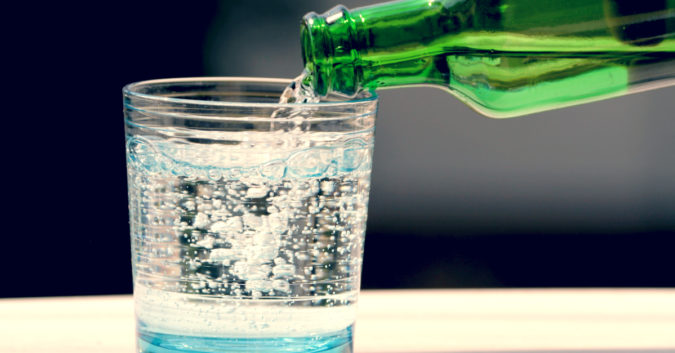In recent years, PFAS, or per- and polyfluoroalkyl substances, have often made national news due to the deadly health risks they pose to drinking water around the United States. These controversial toxic chemicals — and others like them — have even been the subject of a recent Best-Picture-nominated film, Dark Waters, starring Mark Ruffalo.
Also known as “forever chemicals,” PFAS have now been found in a number of popular bottled waters, with especially high levels detected in sparkling or carbonated waters.
The study, published in Consumer Reports, found PFAS levels in bottled waters to be considerably higher than the safe limits identified by many experts.
PFAS chemicals are a class of man-made chemicals favored for their non-stick and anti-corrosive properties. They’ve been used in a variety of consumer products since the 1940s, most notably in:
- Non-stick pans
- Stain-resistant fabrics
- Food packaging
- Firefighting foam
Only within the past decade, however, has research emerged showing PFAS substances to be dangerous to human health and the environment. After all, they’re nicknamed “forever chemicals” because they do not break down in nature.
Which Sparkling Waters Contain PFAS?
Several studies have found “forever chemicals” to be present in a majority of municipal water supplies, suggesting rampant contamination from decades of chemical manufacturing as well as decades of using PFAS-containing firefighting foam to combat fires. However, the new Consumer Reports study adds another frightening angle to the widespread presence of PFAS.
Researchers studied 47 bottled waters, including 12 carbonated and 35 non-carbonated varieties. While only 2 non-carbonated bottles — Tourmaline Spring and Deer Park — exceeded the lowest advisable cutoff for safe consumption (1 part per trillion), 7 of the 12 carbonated bottles tested over the limit.
Those brands include:
- Bubly™
- Canada Dry
- La Croix®
- Perrier®
- Poland Spring®
- Polar®
- Topo Chico®
Polar and Topo Chico registered the highest PFAS levels, at 6.41 and 9.76 parts per trillion (PPT), respectively.
According to CBS News, bottled water is the No. 1 most popular drink sold in the United States, representing some $30 Billion in annual sales.
"There was a real genuine interest looking at what exactly are consumers getting for all that money they are spending," Ryan Felton, the investigative reporter at Consumer Reports who worked on the study, told CBS News.
The study comes on the heels of another new study from the Environmental Working Group (EWG), which estimates that more than 200 million Americans may have PFAS in their drinking water at levels that are 1 PPT or higher.
It’s important to note that, while many health experts believe 1 PPT is a reasonably safe limit for PFAS consumption, these chemicals are not currently regulated by the federal government.
Moreover, unlike other toxins, forever chemicals cannot be broken down in the body, so they simply accumulate over time.
Why Are PFAS Being Found in Water?
Given the widespread use of PFAS — not to mention their well-known toxicity — how is it that companies have been free to use them as they please, and why?
The legality of forever chemicals remains an ongoing controversy, with the standard power dynamic between those who would ban or regulate the chemicals on one side, and the much more powerful and well-financed industries who depend on them on the other.
Because the chemicals have been leaching into the air, water, and soil from industrial sources for decades, their presence is not always known or quantified.
Additionally, PFAS present a particular risk to U.S. military firefighters, as the military widely used PFAS-containing firefighting foam for around 60 years. Firefighters who were assigned to airports are also at risk because airports required the use of the foam until 2018.
The U.S. Centers for Disease Control and Prevention (CDC), the U.S. Environmental Protection Agency (EPA), and the American Cancer Society (ACS) have all acknowledged that certain PFAS may be linked to cancer in firefighters.
Some of the cancers linked to PFAS include:
- Kidney (renal) cancer
- Testicular cancer
- Pancreatic cancer
- Bladder cancer
- Leukemia
- Lymphoma
- Neuroendocrine tumors
- Prostate cancer
- Liver cancer
- Breast cancer
- Colorectal cancer (colon and/or rectal cancer)
Given the extreme durability of PFAS, these chemicals do not break down over time, often remaining in the body for years.
If you worked as a firefighter and were diagnosed with one of these PFAS cancers, contact us today. You may be eligible for financial compensation.
What Is Being Done About PFAS?
The Coca-Cola Company, which owns and sells Topo Chico, told Consumer Reports it would “continue to make improvements to prepare for more stringent standards in the future.” On the other hand, Nestle, makers of Poland Spring and Perrier, denied Consumer Report’s findings outright.
While the EPA has promised to introduce regulatory measures to combat PFAS, the anti-regulatory direction of the EPA under the current administration has more or less resolved to stall or do nothing about it.
Meanwhile, it is a known fact that Dupont and 3M, the main producers of two of the most harmful PFAS chemicals (PFOA and PFOS), hid research showing the chemicals to be harmful to human health.
In addition to cancer, PFAS has been linked to high cholesterol, birth defects, and thyroid problems. According to the EWG, the substances are believed to be present in the blood of 99% of Americans.
All brands are trademarks of their respective companies.
